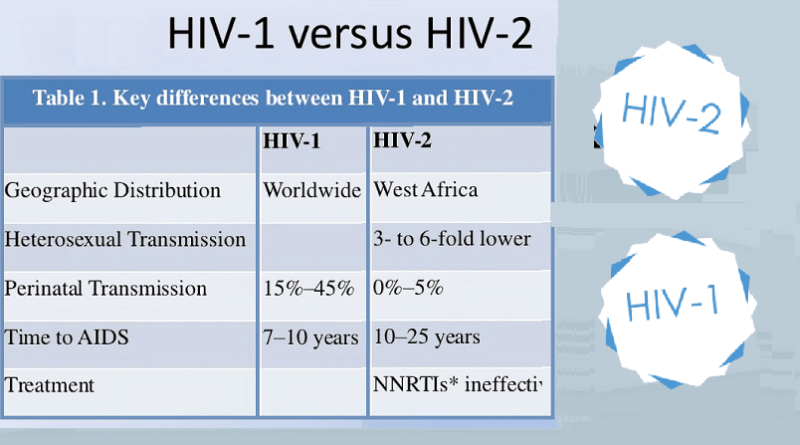HIV Types (HIV-1 & HIV-2): Understanding HIV-2
Human immunodeficiency virus (HIV), both types, is a virus that attacks the immune system and causes acquired immunodeficiency syndrome (AIDS). It was first identified in 1981 and has since become a global pandemic.
HIV can be classified into two types: HIV-1 and HIV-2. Both types are similar in many ways, but there are also important differences between them.
HIV Types (HIV-1 & HIV-2)
This article aims to provide an in-depth understanding of the key differences between HIV-1 and HIV-2, including their origins, characteristics, and modes of transmission.
What is HIV Type-1?
HIV-1 is the most common and virulent strain of the virus. It is responsible for the majority of HIV infections and AIDS cases worldwide. The origin of HIV-1 is believed to be in West Africa, where it likely crossed over from non-human primates to humans, then became human to human. It then spread globally through travel and sexual contact. HIV-1 is highly infectious and can rapidly progress to AIDS if left untreated. It can be transmitted through blood, semen, vaginal fluid, and breast milk.
What is HIV Type-2?
HIV-2: HIV-2 is a less common and less virulent strain of the virus that primarily affects people in West Africa. Like HIV-1, the origin of HIV-2 is believed to be in West Africa, where it crossed over from non-human primates to humans. However, it has not spread globally as extensively as HIV-1. HIV-2 is less infectious and progresses more slowly to AIDS compared to HIV-1. It can be transmitted through the same bodily fluids as HIV-1, but it is less easily transmitted through sexual contact.
Differences between the two HIV Types
A. Mode of Transmission: While both types of HIV can be transmitted through blood, semen, vaginal fluid, and breast milk, HIV-1 is more easily transmitted through sexual contact compared to HIV-2.
B. Disease Progression: HIV-1 progresses more rapidly to AIDS compared to HIV-2, which has a slower progression.
C. Antibody Detection: Antibodies produced in response to HIV-1 and HIV-2 can be detected by tests, but some tests may not accurately detect HIV-2.
D. Treatment and Medication: HIV-1 and HIV-2 are both treatable, but the medications used for treatment may differ between the two types.
| Differences | HIV-1 | HIV-2 |
|---|---|---|
| Origin Start Dicovered | West Africa First | West Africa Later |
| Transmission Sex Trans Mother to Baby | Sexual, blood-to-blood, mother-to-child Faster 15% – 45% | Sexual (less), blood-to-blood Slower (3 times) Less than 5% |
| Infectivity/Virulence Incubation | High 2 to 4 weeks | Low 2 to 4 weeks |
| Progression to AIDS | Faster 7-10 years | Slower 10-25 years |
| Tests Ab tests | ELISA, Western Blot Accurate | ELISA, Western Blot, Line Immunoassay Less accurate |
| Treatment | Antiretroviral therapy | Antiretroviral therapy |
| Prevalence | Global | Mainly in West Africa |
Diagnosis and Testing of HIV
Tests for HIV-1 and HIV-2 include antibody tests, antigen/antibody tests, and nucleic acid tests (NATs). While tests for HIV-1 are generally accurate, tests for HIV-2 may not be as accurate and may require follow-up testing. Early diagnosis is critical for effective treatment and management of both HIV types.
Prevention and Management
Safe sex practices, such as condom use and pre-exposure prophylaxis (PrEP), can help prevent the transmission of HIV-1 and HIV-2.
SUMMARY
Understanding the differences between HIV Types, (HIV-1 and HIV-2), is crucial for proper diagnosis and treatment. Early diagnosis and effective treatment, as well as prevention measures, are important in controlling the spread of HIV-2. This article provides a comprehensive overview of the key differences between the two types of HIV and highlights the importance of addressing the issue of HIV-2.
SOURCES
- HEALTH!! HUMAN IMMUNE VIRUS, SUBTYPES, GROUPS CONTINUE » NAIJAHITZ
- HIV (who.int)
- http://www.ncbi.nlm.nih.gov/pubmed/23444290
- http://www.aidsmap.com
- http://www.avert.org/professionals
- http://cid.oxfordjournals.org/content/38/10/1447.full





Good evening, thank you doctor for your continued concern and for your humanitarian work. I took the combo test and the result was negative after 29 days.
Is it considered final after this period
Is it scientifically final after this period?
And is there a seroconversion after 4
Weeks, and are there rare cases after 4 weeks, because many countries, especially America and Europe, changed the recommendation from 4 weeks to 6 weeks?